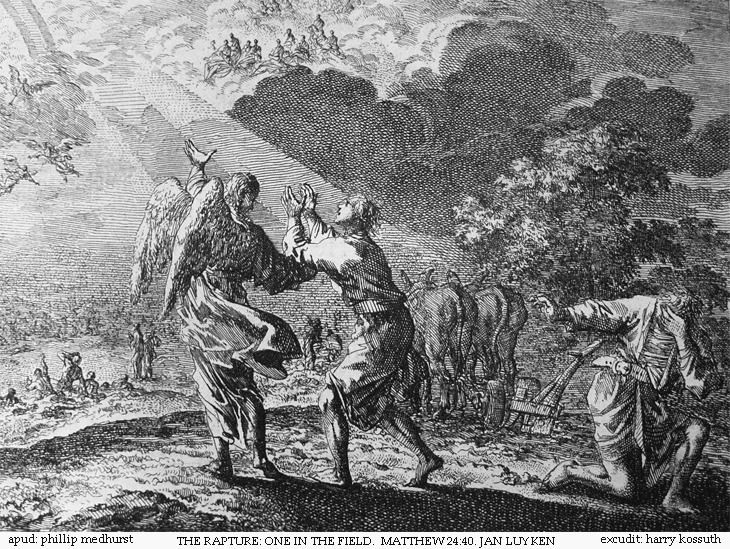 | ||
In Christian eschatology, the post-tribulation rapture doctrine is the belief in a combined resurrection and rapture of all believers coming after the Great Tribulation.
Contents
Doctrine and implications
This doctrine holds that there is a resurrection of dead believers and rapture or translation (or a taking-up/catching-away) of living believers in Jesus Christ at the end of the age (or the "End time"). Post-tribulationists believe that Christians will remain on the Earth throughout a whole 7-year Tribulation period which includes the last three and a half years, which some differentiate by calling the last three and a half years the Great Tribulation period. The main and distinguishing feature of Post-Tribulationalism is that it holds that the Rapture will occur after a 7-year Tribulation period and not before it as in Pre-tribulationism or after 3 1⁄2 years as in Mid-Tribulationalism. This period starts at the Abomination of Desolation and ends at the Battle of Armageddon. They will be taken up (or raptured) to meet Christ in the air (raptured) at the Christ's second coming immediately after the great tribulation just before the battle of Armageddon and then return with Him as Christ descends to the Earth, to usher in the Millennium—the 1000-year reign of Christ on Earth]. This is usually understood as being in line with Historic Premillennialism.
For additional references, see also the parallel passages from Mark 13:24-27 and Luke 21:20-28. While the passages in Luke 21 parallels Matthew and Mark, it offers a couple of interesting clarifications. This passage in Luke offers interesting references to some of the major events which are greatly elaborated on in the Book of Revelation. Reading all three Books of the Bible in parallel, it would appear that Luke elaborates on the "abomination of desolation" describing Jerusalem being surrounded by the armies of the world and of Jerusalem's imminent destruction (Luke 21:20).
Paul's statement "the dead in Christ will rise first" (1 Thessalonians 4:16) can be seen as having its fulfillment (according to a literalist reading of the letter of the biblical text) only after the end of the tribulation (Revelation chapters 6–19) after Satan has been bound (Revelation 20:1-3), and at the beginning of the millennial reign, when
They came to life, and reigned with Christ a thousand years. The rest of the dead did not come to life until the thousand years were ended. This is the first resurrection. Blessed and holy is he who shares in the first resurrection! Over such the second death has no power, but they shall be priests of God and of Christ, and they shall reign with him a thousand years. (Revelation 20:4-6)
Another account which lends support to the idea of a post-tribulation rapture is in 2 Peter 3:10-13, where the idea of the "Day of the Lord" coming as a "thief in the night" comes from. This idea of imminence, according to the post-tribulation view, only applies to the wicked and the spiritually unprepared people that are still alive before the Return of Christ. Therefore, only God's elect (Christians) will fully have a clear understanding of the timing of the second coming, and therefore Christ's coming will not catch the believers by surprise, but only those who are spiritually ignorant regarding the truth. In the passage of 2 Peter 3:10-13, Christ's return is equated with the "elements being melted", and "the earth also and the works therein shall be burned up". Opposing views are not non-existent within the realm of Christian Eschatology. Two opposing views, pre-tribulationism and mid-tribulationism, see the rapture and the Second Coming (or Greek, paraousia) of Christ as separate events; while in post-tribulationism the two events are identical or simultaneous.
Another key difference between the pre-, mid-, and post-tribulation lines of theology is the number of times that Jesus Christ must return. Although it is not directly referenced, in both the pre- and mid-tribulation raptures, Christ must then return a third time, at the end of the tribulation period.
The belief is that God's Elect from all ages will be translated from mortal bodies into immortal glorified bodies at the Second Coming of Christ and that this will be at the end of the age. This event, it is believed, will come at the conclusion of what is termed the 70th Week of Daniel, the final seven years of this present age. This view was held by the early Church Fathers and has been held by Christians since that time. The doctrine of the post-tribulation rapture is today held by a growing number of evangelical Christians. For post-tribulationists concerned about the recent decline of Christian faith, doctrine, and morals in the western church, an important reason to advance the post-tribulation rapture doctrine relates to the importance of preparation of believers for "witness under trial".
Another idea is that following the Great Tribulation, the False Prophet, or the "beast out of the earth" and the Antichrist or the "beast out of the sea" will be condemned upon Jesus Christ's return, and all those who endured or died for Christ's return will be raptured to heaven and, following the Millennium, Satan will be condemned and the remaining dead believers will be raised and raptured into the new heaven.
Opposing doctrines
Opposing doctrines include:
